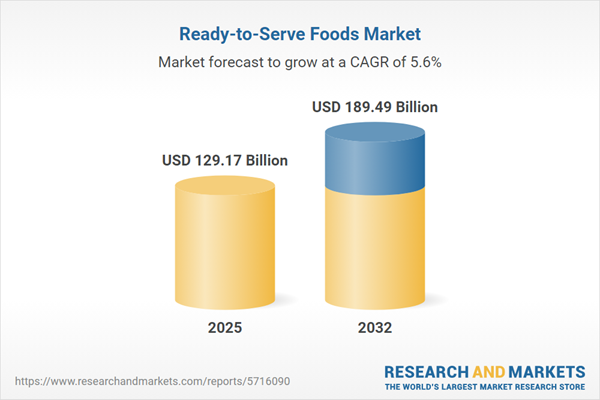Speak directly to the analyst to clarify any post sales queries you may have.
Senior executives navigating the ready-to-serve foods market operate in a landscape shaped by rapid consumer shifts, advancing food technologies, and increasing operational complexity. Strategic innovation and adaptability are now essential for sustained competitive advantage and long-term growth.
Market Snapshot: Ready-to-Serve Foods Market Size and Growth Outlook
The ready-to-serve foods market reached USD 122.27 billion in 2024, with forecasts projecting it will climb to USD 129.17 billion by 2025 and USD 189.49 billion by 2032, reflecting a compound annual growth rate (CAGR) of 5.62%. This upward trend is underpinned by increased consumer demand for convenient meal options that align with evolving nutritional expectations. Strengthened distribution networks and optimized supply chains are streamlining market access and reducing logistics friction. Organizations that act on these underlying trends are better positioned to anticipate customer requirements, navigate emerging regulations, and build leadership in an increasingly competitive sector.
Scope & Segmentation in the Ready-to-Serve Foods Market
- Product Types: Ready meals, salads, snacks, soups, breakfast foods, entrées, and side dishes enable providers to target multiple consumption occasions while addressing varying demands for convenience and nutrition among consumers.
- Packaging Types: Canned, chilled, frozen, blast-frozen, individual quick-frozen, and shelf-stable solutions extend product lifespan, streamline storage and logistics, and can support sustainability goals set by both manufacturers and regulators.
- Distribution Channels: Supermarkets, e-commerce platforms, and convenience stores facilitate broad market penetration, enabling businesses to build omnichannel strategies and meet buyers in their preferred purchase environments.
- End Users: Households, quick-service restaurants, and full-service dining establishments each represent distinct demand profiles, prompting the need for adaptable supply chain models and flexible offerings suited to diverse operational needs.
- Protein Sources: Beef, chicken, seafood, and vegetarian options expand portfolios, supporting swift adaptation to dietary shifts, wellness trends, and growing priorities around ethical sourcing across global markets.
- Price Tiers: Mass market, premium, and ultra-premium segments help tailor value propositions and refine customer engagement for different buyer groups, enhancing market segmentation efforts.
- Regions: The Americas, Europe, Middle East & Africa, and Asia-Pacific each feature unique regulatory, consumer, and cultural dynamics. Localized approaches and understanding of regional challenges are critical for successful expansion and sustained growth.
- Key Players: Sector direction and innovation come from established companies like Nestlé S.A., Conagra Brands, The Kraft Heinz Company, Campbell Soup Company, General Mills, Hormel Foods, Ajinomoto Co., McCain Foods, Nomad Foods, and Unilever PLC, who collectively influence standards and future developments.
Key Takeaways for Senior Decision-Makers
- Expanding product portfolios with wellness-centric and easy-to-prepare items enables organizations to address rising consumer expectations for nutrition and convenience across multiple segments.
- Investing in digital integration across supply chain and sales operations improves responsiveness and promotes seamless customer experiences both online and offline.
- Pursuing sustainable packaging and resilient sourcing strategies supports regulatory compliance and maintains a positive brand reputation with business partners and procurement leads.
- Personalized nutrition offerings differentiate brands and facilitate customer loyalty, particularly within premium and niche regional segments.
- Flexible pricing models and adaptable business strategies enhance organizational resilience and foster deeper, value-driven partnerships amid shifting economic or regulatory pressures.
- Customized approaches addressing diverse regulations, market characteristics, and cultural influences across global regions unlock new business opportunities and secure competitive positioning.
Tariff Impact: Navigating Regulatory Shifts in the Ready-to-Serve Foods Market
Recent tariff changes in the U.S. have elevated costs for raw materials and packaging, encouraging companies to shift sourcing closer to home where feasible. Foodservice operators are adapting their approach by renegotiating supplier terms and narrowing product lines to control supply cost fluctuations. Adoption of automation and advanced logistics further supports efficient operations, enabling firms to manage risk and adapt rapidly to evolving regulatory environments.
Methodology & Data Sources
This research draws from executive interviews, targeted consumer surveys, well-respected industry publications, government regulations, and real-time market databases. Advanced time-series analysis and regression models are applied to provide senior leaders with actionable, market-specific insights.
Why This Report Matters for Decision-Makers in the Ready-to-Serve Foods Market
- Enables leaders to proactively anticipate changes in market dynamics and compliance requirements, supporting organizational agility and greater risk preparedness.
- Clarifies the impact of digital transformation, sustainable practices, and regulatory developments on value chain efficiency and competitive positioning.
- Delivers frameworks and insights to guide executive decisions, mitigate emerging risks, and strengthen commercial partnerships in a rapidly transforming sector.
Conclusion
By leveraging data-driven insights and resourceful adaptation, today’s senior decision-makers can confidently steer their organizations through ongoing change in the ready-to-serve foods sector and secure a trajectory of sustained market relevance.
Additional Product Information:
- Purchase of this report includes 1 year online access with quarterly updates.
- This report can be updated on request. Please contact our Customer Experience team using the Ask a Question widget on our website.
Table of Contents
3. Executive Summary
4. Market Overview
7. Cumulative Impact of Artificial Intelligence 2025
Companies Mentioned
The companies profiled in this Ready-to-Serve Foods market report include:- Nestlé S.A.
- Conagra Brands, Inc.
- The Kraft Heinz Company
- Campbell Soup Company
- General Mills, Inc.
- Hormel Foods Corporation
- Ajinomoto Co., Inc.
- McCain Foods Limited
- Nomad Foods Limited
- Unilever PLC
Table Information
| Report Attribute | Details |
|---|---|
| No. of Pages | 196 |
| Published | October 2025 |
| Forecast Period | 2025 - 2032 |
| Estimated Market Value ( USD | $ 129.17 Billion |
| Forecasted Market Value ( USD | $ 189.49 Billion |
| Compound Annual Growth Rate | 5.6% |
| Regions Covered | Global |
| No. of Companies Mentioned | 11 |









